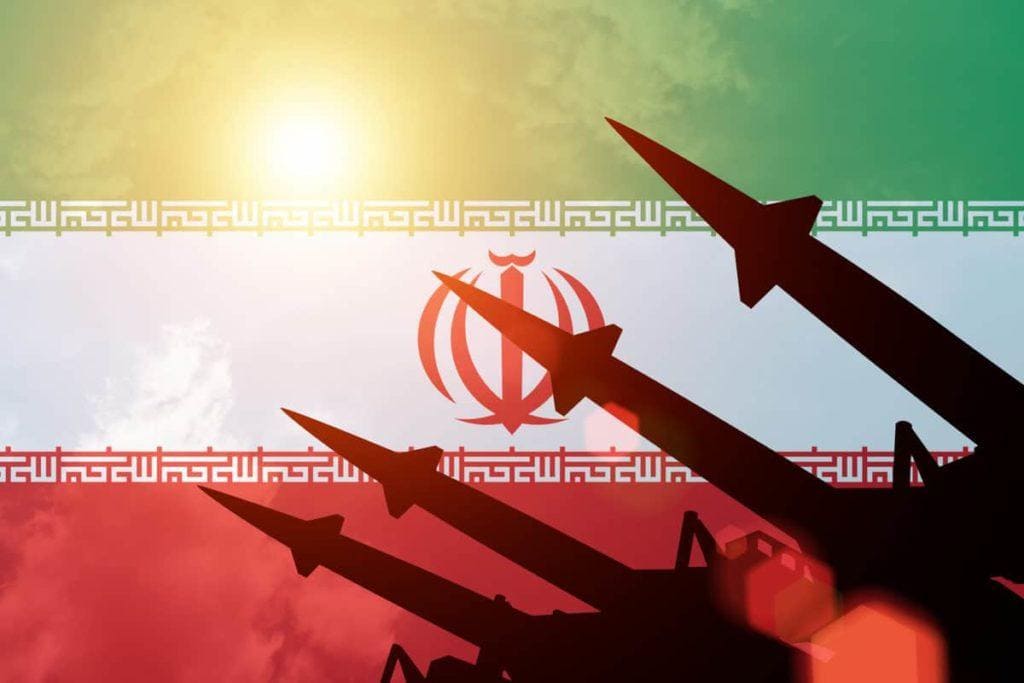Should Israel Be Worried? Iran Is Showing Off Its New “Missile City”
Originally published by The National Interest.

Antiaircraft rockets silhouettes on background of Iran flag. Sunny.
As geopolitical tensions in the region continue to ramp up, Tehran’s growing missile capabilities will pose more and more challenges to Israel and the United States.
2024 was arguably the annus horribilis for the Islamic Republic of Iran. From grappling with the aftermath of Israel’s direct barrages and witnessing the near collapse of its regional proxy terror affiliates to losing its hold on Syria via the collapse of the Assad government, Tehran has a lot to prove in the new year.
According to state-run news outlets, the Iranian regime is using its missile arsenal to caution its adversaries. This week, the Islamic Revolutionary Guard Corps (IRGC) Navy debuted another underground missile base in the coastal regions of southern Iran. IRGC Navy Chief Alireza Tangsiri pledged that Tehran was preparing “to confront any enemy, at any scale, in any manner, and in any geography.” IRGC Chief Commander Hossein Salami mirrored this rhetoric, warning its enemies to “make more precise calculations and to ensure they do not make mistakes that would put both themselves and others in trouble.”
This is not the first time Iran has unveiled a new “missile city.” In January, the IRGC Navy debuted another underground naval missile base near the Persian Gulf, and the IRGC’s Aerospace Force showcased a similar below-ground missile city days earlier. The regime undoubtedly touts its underground stockpiles as a way to show its adversaries that it would still have access to arms if attacked.
Iran’s Formidable Missile Arsenal:
Tehran’s missile arsenal has greatly expanded over the last decade. The regime’s weapons load now includes highly accurate ballistic missiles, drones and cruise missiles. Initially, Iran likely prioritized its rapid missile development in order to achieve its goal of developing nuclear delivery systems. However, over the years, Tehran has seen just how useful these weapons can be in the hands of its regional proxy affiliates.
The IRGC has specifically used its advancing arsenal of missiles to carry out barrages targeting oil facilities in Saudi Arabia, the Islamic State in Syria, and Kurdish groups in northern Iraq. Perhaps more significantly, Iranian-backed militias in the region—including Hezbollah in Lebanon, Hamas in Gaza, and the Houthis in Yemen—have reaped the benefits of this growing arsenal.
Tehran’s Missile Capabilities Are Advancing:
As demonstrated by Iran’s airstrikes targeting Israel in 2024, the IRGC possesses a range of ballistic and cruise missile capabilities. The regime’s longest-range weapons are allegedly able to strike targets up to 2,000 kilometers (1,240 miles) away.
While Tehran does not currently possess an intercontinental ballistic missile (ICBM), which would provide an even longer range, it is certainly striving to achieve that goal. Earlier this month, Tehran test-fired an anti-ship cruise missile with a range of 1,000 miles. This capability would give the regime the option of targeting U.S. Navy warships operated in the Sea of Oman and the Persian Gulf.
And the Strait of Hormuz, the critical waterway that sees nearly one-fifth of the world’s oil shipments pass through it annually, is under regular threat from Iran—both through missiles and other asymmetric tactics like speedboats. As geopolitical tensions in the region continue to ramp up, Tehran’s growing missile capabilities will pose more and more challenges to Israel and the United States.
Read more HERE.
- Iran’s Growing Missile Arsenal Is a Challenge for Israel - November 18, 2025
- IAI Is Hoping to Secure a Contract for the “Golden Dome” - November 3, 2025
- Trump dispatches B-1 bombers and other military assets to Venezuela - October 28, 2025
